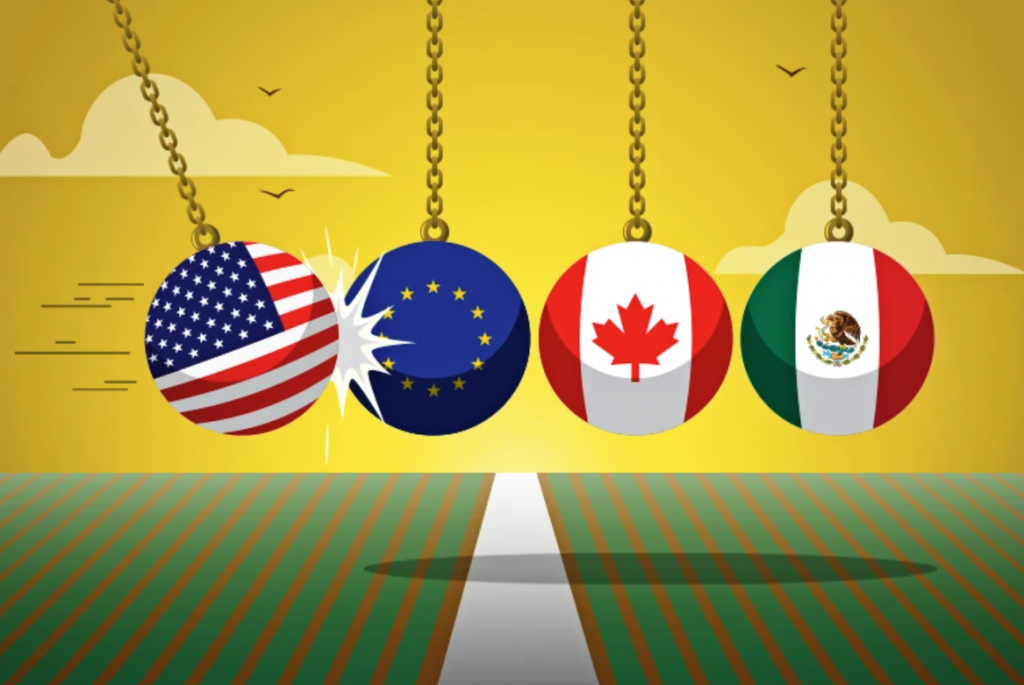
In a Farm Journal Story Matthew Grassi writes: Farm equipment manufacturers have spent the past nine months dealing with tariff fallout and implications. It’s an effort borne out of sheer necessity — that’s because the various tariff levels and targets have changed faster than a Kansas prairie headwind during spring planting.
It’s why we talked with executives from a handful of farm equipment manufacturers to learn more about how they are managing the situation. John Deere, for example, recently went as far as attaching a hard number to the tariff pain: a projected $600 million in balance sheet impact for 2025 is the figure shared by John Beal, director of investor relations, during Deere’s 2025 Q3 earnings call.
On Aug. 18, a 50% tariff on all foreign steel and aluminum imports into the U.S. went into effect. That alone has had a huge impact on the companies building farm machines here in the U.S. and abroad, and it’s even restricting the movement of used farm equipment across the border.
Almost All American Made
Case IH’s Kurt Coffey, who serves as the companies’ vice president of its North America division, says the executive team he is on meets daily to unpack global trade developments. Case IH is in a good position overall, he says, with 80% to 90% of its machines produced in one of four U.S. production facilities, and 95% of its machinery base material (i.e. steel) sourced domestically.
What we’re trying to do is scale across our business to where there are impacts in the short term, in the transitory period, and make sure that we continue to flow product so we’re a reliable partner for our customers,” Coffey says. “But it is anybody’s guess where this is going. So, we’re maintaining focus on the customer and our supply flows.”
That supply flow is worth the extra effort in Racine, according to Coffey, due to this fact: Anywhere from 60% to 90% of Case IH machinery is presold, so a new tariff today means a big, unexpected extra cost tacked on the back end.
“We’re executing on product that was sold three, five or even eight months ago,” he adds. “So, no comment on [financial] impacts, but we’ve continued to focus on how we make sure our customers have what they need as they’re going to harvest.”
Coffey doesn’t come right out and say it, but reading between the lines, it seems clear that Case IH has had to flex its creative muscles and figure out how to manage, for example, a new 50% tariff bill on a brand-new AF-11 combine that was sold six months ago. That extra 50% wasn’t part of the equation when the deal was signed, so who pays for it?
More EU Than U.S.
While Case IH has a large manufacturing base in the U.S., German-based manufacturer Claas is a different story. While the company builds its Lexion combines and self-propelled corn detassler machine at a 250,000-sq.-ft. facility in Omaha, Neb., four-fifths (80%) of its row crop machinery portfolio is built over in Europe and shipped to dealer lots in the U.S.
In a Trump Tariff world, that means significantly higher production costs for Claas, and potentially, the farmers that buy their tractors and combines. That’s because tariffs are taxes, and most companies will pass that extra cost down the line to consumers in the form of higher retail prices.
Eric Raby, senior vice president of the Americas region, Claas, says his outfit is actually taking on some of those extra costs.
From an EU [European Union] perspective, and in Canada and some other major countries, we’re pretty even keel right now on where the tariffs are, and I think the industry as a whole has pretty much absorbed [a lot of] those,” he says. “We’ve absorbed a lot, as well. We’re not passing all of it to the customer.”
The new-ish 50% tariff on steel and aluminum is a different story, however.
“We’re still working [on that] right now and trying to figure out the implications, because that really is going to affect our industry much more broadly than just the tariffs on a country of origin for a specific machine,” Raby says. “We’re always looking for local [material] suppliers as well, because our time to market gets shortened considerably. So, it’s much more efficient for us as well.”
One way to manage those costs is to onshore more of its material sourcing network here into the U.S. We visited Claas’ Omaha factory this summer, and efforts were already underway to find more suppliers in Nebraska and the Midwest.
“We’re always looking at broadening our supplier base,” Raby says. “If we go back to COVID, I think the whole industry suffered from a lack of versatility within the supply chain. So we’re always looking for different suppliers. And then obviously, with the tariffs now, we’re looking even more intently on sourcing locally.”
Nearly 50/50
New Holland is largely viewed as a Euro-brand in farm equipment circles, but it’s closer to an even split. The company manufactures about 50% of it’s row-crop machinery in the EU and 40% in North America, with the remaining 10% built in the Asia-Pacific region.

New Holland’s vice president of North America, Ryan Schaefer, has been in the leadership role for the brand’s domestic operations for about a year now. He says CNH Industrial has eight manufacturing plants in the U.S. as well as a significant presence in western Canada, but managing the tariff situation has been anything but easy, he says.
“We produce tractors and combines all over the world, as well, so we truly have a global footprint,” he says. “So really, I wouldn’t go so far as to call the situation difficult, but the challenges are something that many in our industry have never had to deal with firsthand. It’s been a learning experience for all manufacturers, I would say, throughout North America and the globe.”


















